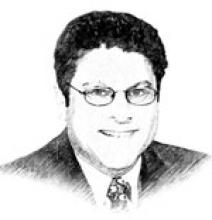User login
I observe with sadness the decreasing number of our brightest medical students entering into internal medicine careers and other “cognitive” subspecialties. Much effort has been spent on many fronts to understand and reverse this trend, with limited success.
At the other end of their careers, physicians seem to be looking for ways to retire earlier or to withdraw from their usual and customary practice of internal medicine. Hearing these senior physicians’ reasons for withdrawing from clinical practice evokes an even stronger response in me, especially when the physician is a really good one, a role model for the next generation of our internists currently in training.
In an essay in this issue, Dr. Thomas Lansdale, internist and former chairman of medicine at a community teaching hospital, eloquently expresses a common theme: medicine just isn’t that much fun anymore. We don’t generally run this type of article in the Journal. But Dr. Lansdale’s words reflect an undercurrent that is changing the landscape of American medicine. We would like to hear responses from our readers, but not to simply agree or disagree with Dr. Lansdale. Rather, we’d like to hear some solutions, which we hope to print in a future issue.
I have known Dr. Lansdale for over 20 years; we trained together as residents at the University of Pennsylvania. He was a year or so behind me, and over the years I have had the opportunity to follow his clinical career from afar and occasionally to discuss patient care and education issues. He was (and is) a thoughtful and extremely insightful internist, devoted and capable of delivering the highest quality of care to his patients. He has always approached medicine, his trainees, and his patients in a serious and respectful manner. His words should prompt some serious self-reflection.
Send your comments to [email protected]. Please note that sending your comments constitutes permission to publish them, and also that we cannot respond to or publish all submissions.
I observe with sadness the decreasing number of our brightest medical students entering into internal medicine careers and other “cognitive” subspecialties. Much effort has been spent on many fronts to understand and reverse this trend, with limited success.
At the other end of their careers, physicians seem to be looking for ways to retire earlier or to withdraw from their usual and customary practice of internal medicine. Hearing these senior physicians’ reasons for withdrawing from clinical practice evokes an even stronger response in me, especially when the physician is a really good one, a role model for the next generation of our internists currently in training.
In an essay in this issue, Dr. Thomas Lansdale, internist and former chairman of medicine at a community teaching hospital, eloquently expresses a common theme: medicine just isn’t that much fun anymore. We don’t generally run this type of article in the Journal. But Dr. Lansdale’s words reflect an undercurrent that is changing the landscape of American medicine. We would like to hear responses from our readers, but not to simply agree or disagree with Dr. Lansdale. Rather, we’d like to hear some solutions, which we hope to print in a future issue.
I have known Dr. Lansdale for over 20 years; we trained together as residents at the University of Pennsylvania. He was a year or so behind me, and over the years I have had the opportunity to follow his clinical career from afar and occasionally to discuss patient care and education issues. He was (and is) a thoughtful and extremely insightful internist, devoted and capable of delivering the highest quality of care to his patients. He has always approached medicine, his trainees, and his patients in a serious and respectful manner. His words should prompt some serious self-reflection.
Send your comments to [email protected]. Please note that sending your comments constitutes permission to publish them, and also that we cannot respond to or publish all submissions.
I observe with sadness the decreasing number of our brightest medical students entering into internal medicine careers and other “cognitive” subspecialties. Much effort has been spent on many fronts to understand and reverse this trend, with limited success.
At the other end of their careers, physicians seem to be looking for ways to retire earlier or to withdraw from their usual and customary practice of internal medicine. Hearing these senior physicians’ reasons for withdrawing from clinical practice evokes an even stronger response in me, especially when the physician is a really good one, a role model for the next generation of our internists currently in training.
In an essay in this issue, Dr. Thomas Lansdale, internist and former chairman of medicine at a community teaching hospital, eloquently expresses a common theme: medicine just isn’t that much fun anymore. We don’t generally run this type of article in the Journal. But Dr. Lansdale’s words reflect an undercurrent that is changing the landscape of American medicine. We would like to hear responses from our readers, but not to simply agree or disagree with Dr. Lansdale. Rather, we’d like to hear some solutions, which we hope to print in a future issue.
I have known Dr. Lansdale for over 20 years; we trained together as residents at the University of Pennsylvania. He was a year or so behind me, and over the years I have had the opportunity to follow his clinical career from afar and occasionally to discuss patient care and education issues. He was (and is) a thoughtful and extremely insightful internist, devoted and capable of delivering the highest quality of care to his patients. He has always approached medicine, his trainees, and his patients in a serious and respectful manner. His words should prompt some serious self-reflection.
Send your comments to [email protected]. Please note that sending your comments constitutes permission to publish them, and also that we cannot respond to or publish all submissions.
